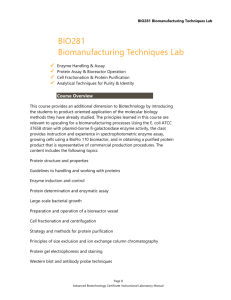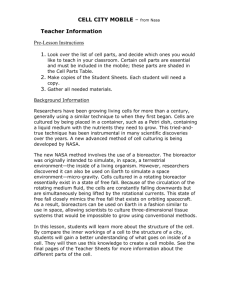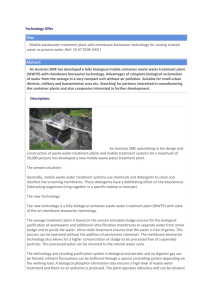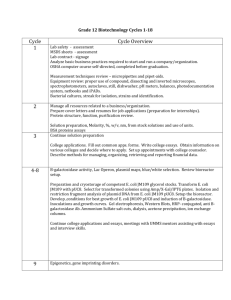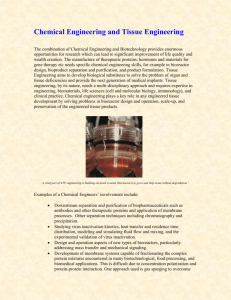Lab Module 1 Media Development and Vessel
advertisement
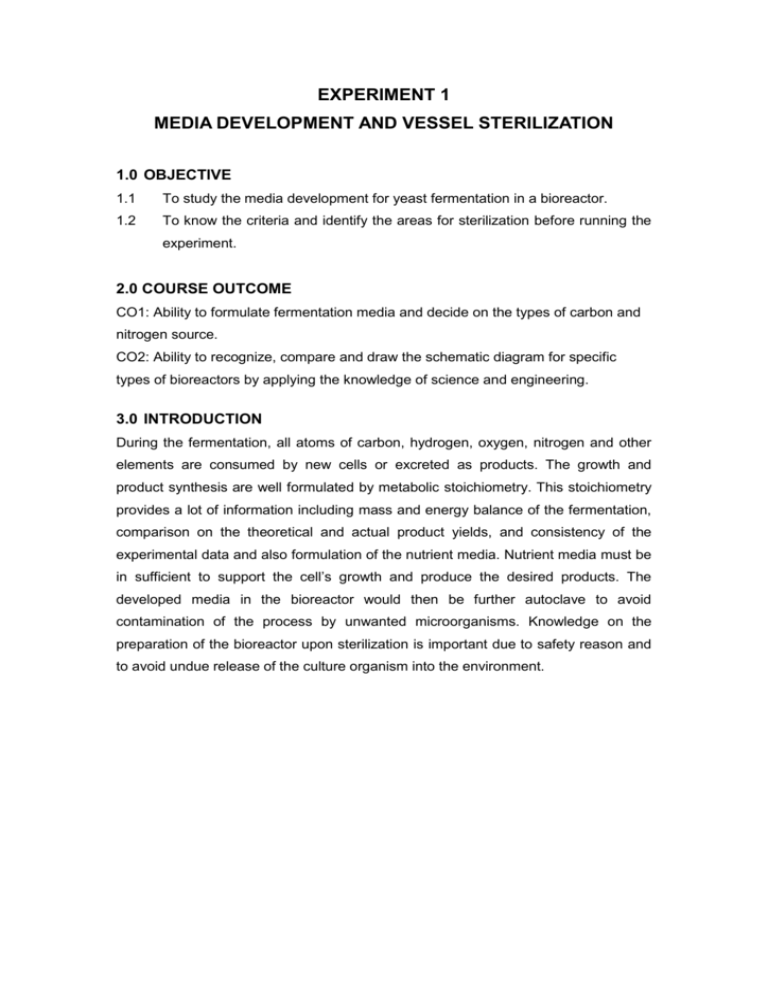
EXPERIMENT 1 MEDIA DEVELOPMENT AND VESSEL STERILIZATION 1.0 OBJECTIVE 1.1 To study the media development for yeast fermentation in a bioreactor. 1.2 To know the criteria and identify the areas for sterilization before running the experiment. 2.0 COURSE OUTCOME CO1: Ability to formulate fermentation media and decide on the types of carbon and nitrogen source. CO2: Ability to recognize, compare and draw the schematic diagram for specific types of bioreactors by applying the knowledge of science and engineering. 3.0 INTRODUCTION During the fermentation, all atoms of carbon, hydrogen, oxygen, nitrogen and other elements are consumed by new cells or excreted as products. The growth and product synthesis are well formulated by metabolic stoichiometry. This stoichiometry provides a lot of information including mass and energy balance of the fermentation, comparison on the theoretical and actual product yields, and consistency of the experimental data and also formulation of the nutrient media. Nutrient media must be in sufficient to support the cell’s growth and produce the desired products. The developed media in the bioreactor would then be further autoclave to avoid contamination of the process by unwanted microorganisms. Knowledge on the preparation of the bioreactor upon sterilization is important due to safety reason and to avoid undue release of the culture organism into the environment. 4.0 MATERIALS AND EQUIPMENTS 4.1 Labelled components of a bioreactor 1 2 6 3 5 4 1. 2. 3. 4. Touch screen control Start button Pump Corrective solution Bottles 5. Culture vessel 6. Stirrer motor Figure 1: Unit construction for Bioreactor 4.2 Bioreactor set-up A bioreactor to be used for this experiment consists of the following equipment and instrumentation: a. A cylindrical gas of nitrogen. b. The bioreactor is fitted with ports for the following: - Electrode sensor: O2 sensor, temperature sensor, pH electrode, antifoam probe, level probe - Gassing tube with ring sparger - Filling port - Double jacket (heating element) - Manual sampler - 3 storage bottles for acid, alkaline, and antifoam agent - Equipped with baffles - Stirrer shaft with mechanical seal - 2 disc impellers - Culture vessel 4.3 Chemical for media development a) Distilled water (1.5L) b) (NH4)2SO4 c) Glucose monohydrate 5.0 PROCEDURES 5.1 Experiment 1: Media Development The growth of beaker’s yeast (S.cerevisiae) on glucose may be described by the following equation: C 6 H12 O 6 3O 2 0.48NH3 0.48C 6 H10 NO3 4.32H 2 O 3.12CO 2 Yeast By considering the volume for the seed culture is 10% from the working volume of fermentation media in 2 liter benchtop bioreactor and the desired yeast concentration of 50 gdw/l, 5.1.1 Determine the concentration and total amount of glucose and (NH4)2SO4 in the nutrient medium 5.1.2 Weigh the required carbon and nitrogen sources 5.1.3 Pour in the prepared media into the bioreactor vessel. 5.1.4 Sterilize the media for 121°C for 15 minutes and let it cool upon inoculation of yeast 5.2 Experiment 2: Vessel Preparation before Autoclave. Preparation of Bioreactor before Autoclave. 5.2.1 Switch on the main power of the bioreactor unit and fill the water inside the jacket heater to the maximum level. 5.2.2 Take out the pH probe and calibrate it appropriately with pH 7 followed by pH 4. Immerse the probe in KCl solution in a conical flask. 5.2.3 Calibrate each of the dosing pumps to get the correct flow rate during the experiment. 5.2.4 Remove the lid and detached all the hosing connected from the main touch panel. All BLACK hosing CANNOT be autoclaved, make sure to remove them before autoclave. Others colour of hosing CAN be autoclave. 5.2.5 Remove motor, all hosing and attached probes from bioreactor. 5.2.6 Rinse the vessel with tap water as much time as necessary to make sure it clean and clear. 5.2.7 Check the electrolyte in the pO2 probe whether it’s still have or not. This is to ensure membrane inside the pO2 probe is protected during autoclave. 5.2.8 Pour 1L liquid media prepared into the vessel. 5.2.9 Reattach the lid back to the vessel. Mount back pH probe and pO2 probe. 5.2.10 Cover the pH, pO2, antifoam, level, temperature sensor and the hoses with cotton and aluminum foil. 5.2.11 Make sure relief valve/filter at the condenser and sampling port are not covered with cotton, just wrap with aluminum foil. 5.2.12 Tubing that is connected to air spurger, sampling pot and from corrective bottles are clipped. 5.2.13 Wrap the male connector with aluminum foil. 5.2.14 Make sure every procedure is performed successfully before autoclave session can be done. 5.3 Maintenance And Safety Precautions 5.3.1 All operating instructions supplied with the unit must be carefully read and understood before attempting to operate the unit. 5.3.2 Turn off the stirrer, pH electrode, pO2 electrode, antifoam, pump at the bioreactor. 5.3.3 Running the bioreactor MUST BE assisted by a trained PLV at ALL times. 5.3.4 Please ensure all safety appliances are worn when operating a high pressure gas line. 5.4 General Shut Down Procedures 5.4.1 Turn the agitator, temperature , dosing pump off. 5.4.2 Close the air sparger valve and turn off the main switch of the touch panel. 5.4.3 Remove the mixer motor from top of the bioreactor and place on top of the apparatus. 5.4.4 Carefully remove the pH and pO2 probe and place in the KCl solution for pH probe, while in the distilled water for pO2 probe. 5.4.5 Remove any hosing attached with the bioreactor and carefully bring the bioreactor to the sink. 5.4.6 Remove the cover and place the cover on top of the bench so that it will not roll off. 5.4.7 Pour the reactor media into the sink and wash thoroughly. Rinse the vessel with distilled water. 5.4.8 Place back the cover to the vessel, and put back the vessel to its position. 6.0 RESULTS AND CALCULATION 6.1 Record the right and wrong parts when preparing the vessel before autoclaved in the given table. NO. 1 2 3 4 5 6 7 RIGHT WRONG 7.0 QUESTIONS 7.1 List down the factors that can cause contamination to your culture. 7.2 Why pH probe needs to be calibrating before autoclave start and pO2 probe after autoclave? 7.3 What are the differences between impeller design for microbial, mammalian, and plant bioreactor and why they are designed in different ways? 7.4 Why microsparger is being used in mammalian bioreactor? 7.5 Give some comment on design for sparger, impeller, baffle and heating element for these three types of bioreactor. 7.6 How much yeast biomass will be produced theoretically from the stoichiometric equation above? 7.7 Determine the yield coefficients YX/S (biomass/glucose) and YX/O2 (biomass/oxygen). 7.8 What will happen if you have mistakenly tighten the lid screw and not clipped the hose for aeration during sterilization? 8.0 CONCLUSION 8.1 What is your suggestion to improve/optimize the fermentation media? 8.2 In your view, what are the improvements that you would recommend for these bioreactors? 8.3 Highlight the most important steps in preparing the bioreactor before sterilization and give your explanation on these steps.

